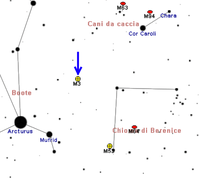Messier 3
| NGC 5272 | |
|---|---|
|
Mount Lemmon SkyCenter image of Messier 3 | |
| Observation data (J2000 epoch) | |
| Class | VI[1] |
| Constellation | Canes Venatici |
| Right ascension | 13h 42m 11.62s[2] |
| Declination | +28° 22′ 38.2″[2] |
| Distance | 33.9 kly (10.4 kpc)[3] |
| Apparent magnitude (V) | +6.2[4] |
| Apparent dimensions (V) | 18′.0 |
| Physical characteristics | |
| Mass | 4.5×105[5] M☉ |
| Radius | 90 ly |
| Tidal radius | 113 ly (30 pc)[mean][6] |
| Metallicity | = –1.34[7] dex |
| Estimated age | 11.39 Gyr[7] |
| Other designations | NGC 5272[4] |
Messier 3 (also known as M3 or NGC 5272) is a globular cluster of stars in the northern constellation of Canes Venatici. It was discovered by Charles Messier on May 3, 1764,[8] and resolved into stars by William Herschel around 1784. Since then, it has become one of the best-studied globular clusters. Identification of the cluster's unusually large variable star population was begun in 1913 by American astronomer Solon Irving Bailey and new variable members continue to be identified up through 2004.[9]


Many amateur astronomers consider it one of the finest northern globular clusters, following only Messier 13.[1] M3 has an apparent magnitude of 6.2,[4] making it a difficult naked eye target even with dark conditions. With a moderate-sized telescope, the cluster is fully defined. It can be a challenge to locate through the technique of star hopping, but can be found by looking almost exactly halfway along an imaginary line connecting the bright star Arcturus to Cor Caroli. Using a telescope with a 25 cm (9.8 in) aperture, the cluster has a bright core with a diameter of about 6 arcminutes and spans a total of 12 arcminutes.[1]
This cluster is one of the largest and brightest, and is made up of around 500,000 stars. It is estimated to be 8 billion years old. It is located at a distance of about 33,900 light-years away from Earth.
Messier 3 is located 31.6 kly (9.7 kpc) above the Galactic plane and roughly 38.8 kly (11.9 kpc) from the center of the Milky Way. It contains 274 known variable stars; by far the highest number found in any globular cluster. These include 133 RR Lyrae variables, of which about a third display the Blazhko effect of long-period modulation. The overall abundance of elements other than hydrogen and helium, what astronomers term the metallicity, is in the range of –1.34 to –1.50 dex. This value gives the logarithm of the abundance relative to the Sun; the actual proportion is 3.2–4.6% of the solar abundance. Messier 3 is the prototype for the Oosterhoff type I cluster, which is considered "metal-rich". That is, for a globular cluster, Messier 3 has a relatively high abundance of heavier elements.[10]
References
- 1 2 3 Thompson, Robert Bruce; Thompson, Barbara Fritchman (2007), Illustrated guide to astronomical wonders, DIY science O'Reilly Series, O'Reilly Media, Inc., p. 137, ISBN 0-596-52685-7.
- 1 2 Goldsbury, Ryan; et al. (December 2010), "The ACS Survey of Galactic Globular Clusters. X. New Determinations of Centers for 65 Clusters", The Astronomical Journal, 140 (6): 1830–1837, arXiv:1008.2755
 , Bibcode:2010AJ....140.1830G, doi:10.1088/0004-6256/140/6/1830.
, Bibcode:2010AJ....140.1830G, doi:10.1088/0004-6256/140/6/1830. - ↑ Paust, Nathaniel E. Q.; et al. (February 2010), "The ACS Survey of Galactic Globular Clusters. VIII. Effects of Environment on Globular Cluster Global Mass Functions", The Astronomical Journal, 139 (2): 476–491, Bibcode:2010AJ....139..476P, doi:10.1088/0004-6256/139/2/476.
- 1 2 3 Messier 3, SIMBAD Astronomical Object Database, retrieved 2006-11-15.
- ↑ Marks, Michael; Kroupa, Pavel (August 2010), "Initial conditions for globular clusters and assembly of the old globular cluster population of the Milky Way", Monthly Notices of the Royal Astronomical Society, 406 (3): 2000–2012, arXiv:1004.2255
 , Bibcode:2010MNRAS.406.2000M, doi:10.1111/j.1365-2966.2010.16813.x. Mass is from MPD on Table 1.
, Bibcode:2010MNRAS.406.2000M, doi:10.1111/j.1365-2966.2010.16813.x. Mass is from MPD on Table 1. - ↑ Brosche, P.; Odenkirchen, M.; Geffert, M. (March 1999). "Instantaneous and average tidal radii of globular clusters". New Astronomy. 4 (2): 133–139. Bibcode:1999NewA....4..133B. doi:10.1016/S1384-1076(99)00014-7. Retrieved 7 December 2014.
- 1 2 Forbes, Duncan A.; Bridges, Terry (May 2010), "Accreted versus in situ Milky Way globular clusters", Monthly Notices of the Royal Astronomical Society, 404 (3): 1203–1214, arXiv:1001.4289
 , Bibcode:2010MNRAS.404.1203F, doi:10.1111/j.1365-2966.2010.16373.x.
, Bibcode:2010MNRAS.404.1203F, doi:10.1111/j.1365-2966.2010.16373.x. - ↑ Machholz, Don (2002), The observing guide to the Messier marathon: a handbook and atlas, Cambridge University Press, ISBN 0-521-80386-1.
- ↑ Valcarce, A. A. R.; Catelan, M. (August 2008), "A semi-empirical study of the mass distribution of horizontal branch stars in M 3 (NGC 5272)", Astronomy and Astrophysics, 487 (1): 185–195, arXiv:0805.3161
 , Bibcode:2008A&A...487..185V, doi:10.1051/0004-6361:20078231.
, Bibcode:2008A&A...487..185V, doi:10.1051/0004-6361:20078231. - ↑ Cacciari, C.; Corwin, T. M.; Carney, B. W. (January 2005), "A Multicolor and Fourier Study of RR Lyrae Variables in the Globular Cluster NGC 5272 (M3)", The Astronomical Journal, 129 (1): 267–302, arXiv:astro-ph/0409567
 , Bibcode:2005AJ....129..267C, doi:10.1086/426325.
, Bibcode:2005AJ....129..267C, doi:10.1086/426325.
External links
- SEDS Messier pages on M3
- M3, Galactic Globular Clusters Database page
- M3 Photo detail Dark Atmospheres
- Merrifield, Michael. "M3 – Globular Cluster". Deep Sky Videos. Brady Haran.
- Messier 3 on WikiSky: DSS2, SDSS, GALEX, IRAS, Hydrogen α, X-Ray, Astrophoto, Sky Map, Articles and images
Coordinates: ![]() 13h 42m 11.23s, 28° 22′ 31.6″
13h 42m 11.23s, 28° 22′ 31.6″

